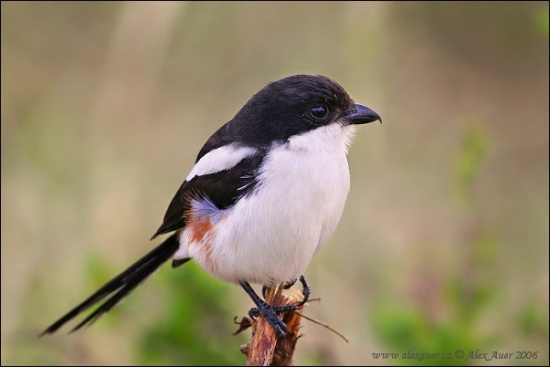- Lanius humeralis
Identification
A pied, heavy-bodied, heavy-billed bird with white wing-bar extending to the shoulders. Female has rufous flanks.
Distribution
Sub-Saharan Africa: Guinea to Eritrea and Ethiopia, south to southern Tanzania, northern Mozambique, Angola, Zambia and Malawi.
Taxonomy
Subspecies
There are 3 subspecies[1]:
- L. c. smithii:
- Guinea to northern Democratic Republic of the Congo, southern South Sudan, and western Uganda
- L. c. humeralis:
- Eritrea and Ethiopia to southern Tanzania and northern Mozambique
- L. c. capelli:
Formerly included in Common Fiscal together with Southern Fiscal.
Habitat
Found in woodland and open savanna, shrubland with scattered trees. Common around cities, gardens, parks and along roadsides.
Behaviour
Compared to the rest of the shrikes, the Northern Fiscal is quite unusual in that a pair will hold a territory throughout the year. Most of the true shrike species (genus Lanius) from the northern hemisphere are migratory, breeding in the northern hemisphere and spending the austral summer in the southern hemisphere.
Diet
The Northern Fiscal is raptorial and feeds on a wide range of invertebrates, notably insects and small vertebrates. Vertebrates comprise a very small portion of its diet and most of its prey are those considered pests to the farmer or gardener. Its main hunting method is sit-and-wait foraging and about three-quarters of its day is spent on the lookout for prey. It also hovers before pouncing and chases and flushes prey out of undergrowth. When flying insects are numerous, such as when winged termites emerge from the ground, the bird will hunt on the wing and in very windy conditions when flight becomes impossible, it will glean prey from foliage.
Breeding
Common Fiscals breed mainly between the months of August and January, with most eggs being laid in September and October. They lay three or four pale, speckled eggs, which hatch about two and a half weeks after being laid, usually over a period of two days and often one or two eggs fail to hatch.
References
- Clements, J. F., T. S. Schulenberg, M. J. Iliff, D. Roberson, T. A. Fredericks, B. L. Sullivan, and C. L. Wood. 2017. The eBird/Clements checklist of birds of the world: v2017, with updates to August 2017. Downloaded from http://www.birds.cornell.edu/clementschecklist/download/
- Avibase
Recommended Citation
- BirdForum Opus contributors. (2024) Northern Fiscal. In: BirdForum, the forum for wild birds and birding. Retrieved 19 April 2024 from https://www.birdforum.net/opus/Northern_Fiscal




